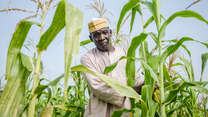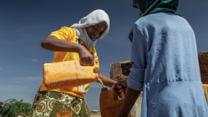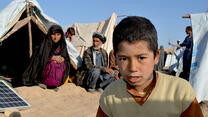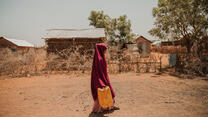WHO WE ARE
The mission of the International Rescue Committee (IRC) is to help people whose lives and livelihoods are shattered by conflict and disaster to survive, recover and gain control of their future. Our vision is that the IRC will lead the humanitarian field by implementing high-impact, cost-effective programs for people affected by crisis, and shape global policy and practice by sharing our learning and experience with others.
All IRC programs are designed to achieve meaningful change in people’s health, safety, education, economic wellbeing and ability to influence the decisions that affect their lives. The Economic Recovery and Development (ERD) unit at the IRC works to ensure that those we serve have their most basic survival needs met and have the combination of assets and income to prosper.
To support agricultural recovery in long-term or post-crisis locations, the IRC works with communities to restore agricultural assets, upgrade skills and practices, and build disaster preparedness to better protect and improve their livelihoods.
WHY OUR WORK MATTERS
2 billion people—nearly one third of the world’s population—depend on small-scale agricultural production to produce food and generate income.
Agriculture is a primary source of food and income for many of the IRC’s beneficiaries. In lower-income countries in Africa and Asia, agriculture employs approximately 50 percent of the workforce. Farming can be a tough way to make a living; it is associated with many risks and can heighten social and economic inequalities, especially for women farmers.
In the contexts in which the IRC works, agriculture is hampered by low productivity, low technical know-how and poor access to markets and credit. Conflict and natural disasters exacerbate underlying vulnerabilities in farming communities, and repeated cycles of violence, drought or flooding, not only destroy infrastructure and erode natural resources, but also contribute to severe human suffering that prevent rural communities from recovering. This cycle pushes rural communities deeper into poverty and accelerates rural migration to urban areas.
In conflict-affected areas, women often shoulder the full burden of productive work while men are forced to fight, imprisoned, killed or flee to generate income elsewhere.
WHAT WE DO
IRC practitioners provide technical assistance to more than 30 country programs. Technical advisors are charged with staying abreast of the best available research and practices in their respective fields and sharing these with the IRC’s frontline teams. They also lead advocacy strategies to encourage partners and policy makers to adopt the interventions proven to be effective based on our research and experience.
The ERD unit’s agriculture and rural livelihoods programming works to increase crop or livestock productivity using safe and environmentally sensitive processes, save labor time by using technology, improve people’s nutrition, and generate income through business trainings and linkages to markets.
Agriculture in Emergencies
When disaster destroys agricultural and rural livelihoods, the IRC supports communities to rebuild infrastructure and continue to produce the food the community needs to survive.
In Syria, before the current crisis, 80% of the rural population earned their living from farming. In 2014, drought reduced the cereal harvest by 31%, and war devastated irrigation infrastructure and fractured the state system that subsidized farmers. The IRC and its partners are supporting 8,000 Syrian farming households with locally-sourced agricultural inputs, tools and training to resume food production.
Market Strengthening
Supporting the recovery and development of agricultural value chains contributes to the sustained economic wellbeing of rural communities. The IRC works with rural communities affected by crises to restart farming businesses to generate income and food. The IRC and partners developed two resources to help relief agencies and our country teams map critical food markets before and during emergencies: (1) Pre-Crisis Market Assessments (PCMA) and (2) Emergency Market Mapping Assessments (EMMA). The IRC uses these tools to identify gaps in market chains and design programs to fill those gaps. In practice, this means the IRC facilitates linkages between value chain actors such as suppliers, producers, traders and consumers and strengthens the enabling environment by providing information on inputs, agricultural knowledge and financing to farmers.
In Northern Uganda, the IRC supported returning refugees and internally displaced persons (IDPs) who had previously been small farmers to re-enter profitable agricultural value chains such as soya, cotton and maize. After a value chain analysis, the IRC identified an opportunity to sell cotton to one of the world’s largest cotton processing firms. Participants were trained in relevant agricultural practices and marketing, and given access to financial services. Collective marketing groups were established, so farmers could work collaboratively and achieve economies of scale to sell their crops and produce. In collaboration with local leaders, buyers and producers, over 750 acres of land was opened for food and cotton crop production. Initial sales of over $25,000 transformed the lives of more than 400 households. Farmers’ average income increased from $560 USD to $1,231 USD, and food crop yields grew by 140%.
Building Resilience through Agriculture
Climate change is intensifying the impact of cyclical and dramatic climate shifts between droughts and flooding that have historically impacted millions of poor and rural communities. The institutional and communal capacities to respond to and mitigate the effects of such disasters are hindered by high poverty levels, conflict and corruption.
The IRC is working on disaster risk reduction (DRR) in Mali, Niger and Chad, strengthening households’ resilience by fostering drought- adapted agricultural production, improving water and sanitation management, and bolstering the financial and physical assets of households. Through technology and training, the IRC increases the capacity of communities to develop local disaster response plans and contribute to national early warning systems.
Food Security
Food security means a family is able to produce or purchase a range of preferred foods and has the knowledge to prepare and consume safe and nutritionally balanced diets that meet the needs of all ages and genders. Agriculture plays a key role in food security by providing;
- household food stocks and contributing to national and global food reserves,
- income from crop and animal sales to purchase food that can’t be grown by the household; and
- nutrient-rich foods.
The IRC provides nutrition-sensitive agriculture programs that address one or more of the underlying causes of malnutrition, such as inadequate food availability or access, poor care and feeding practices, and weak health and sanitation environments. Women’s empowerment and health are critical elements of nutrition sensitive agriculture, because women’s decision-making, control of resources and workload directly impact their ability to provide healthy and nutritious food for themselves and their children.
The IRC implemented food voucher programs in West Africa and Syria through USAID’s Food For Peace initiative to increase people’s access to a balanced diet. In Syria, the voucher scheme was designed to provide nutrient-dense foods that were available in local markets.
Focus on Women and Girls
In the contexts in which we work, women make up a large part of agricultural labor, yet women and girls frequently have little access to and control over land, assets, money, information and credit while taking on the burden of unpaid farming work. Closing the gender gap could increase yields on women-run farms by 20-30% and raise agricultural output in developing countries by 2.5-4% (World Bank 2015).
To address these inequalities, the IRC integrates behavioral change interventions across its agricultural programming. These interventions surface harmful traditional social norms that perpetuate gender inequalities and their crippling impact on economic wellbeing. The IRC increasingly integrates a gender-sensitive lens to agriculture value chain development. For example, the IRC targets female value chains, safely integrates women into traditionally non-female value chains, and works with financial institutions to enhance women’s access to formal and informal financial services.
In Northern Uganda, the IRC provided women with specialized training in production to post harvest processing. Additionally, women’s empowerment trainings, designed to address gender gaps and increase women’s active participation in higher value chain activities, were held with all beneficiaries. As a result, women’s participation in leadership roles increased from 30 to 72 percent, and more women- owned business were established.



